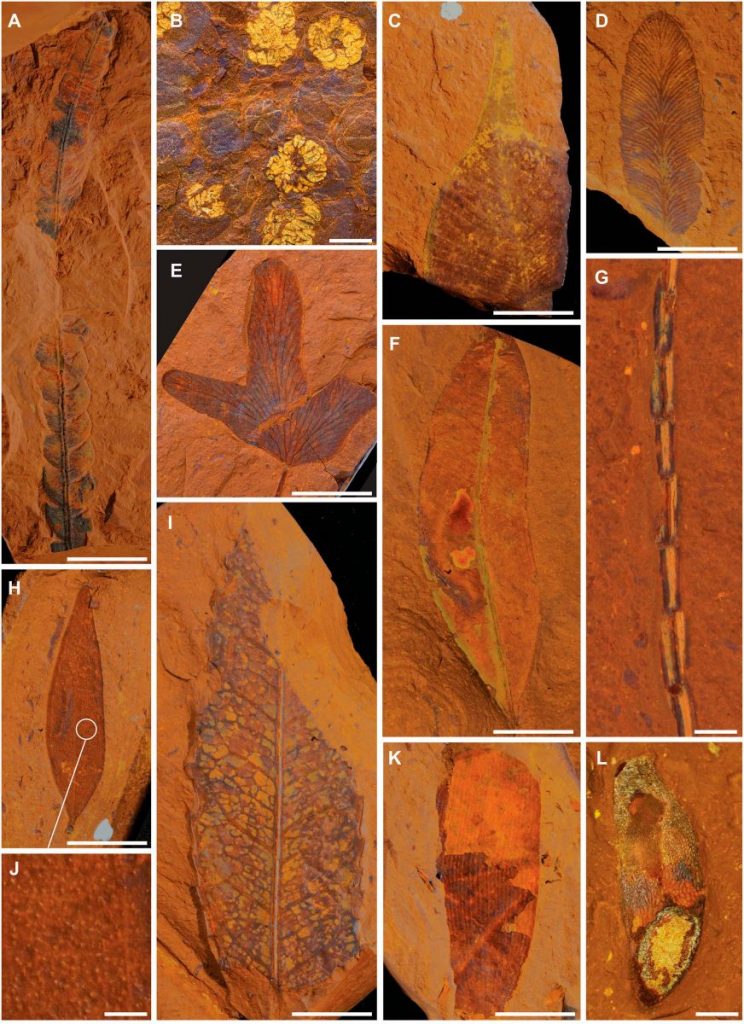It is a rare event when a whole suite of ancient Australian plants is discovered in one place. This recently occurred in ironstone slabs left lying in a field after agriculture at McGraths Flat in the Central Tablelands of New South Wales. Fossils discovered here tell us that there was once a rainforest as well as a dryer sclerophyllous (i.e. hard leaf species) forest twenty-five kilometres northwest of Gulgong. This high diversity of plants and animals dates from 37.3 ± 0.36 million years ago. Dating was achieved using Argon (40Ar/39Ar) geochronology of the nearby basalts.

Plant fossils from McGraths Flat. (McCurry et al., Sci. Adv., 2022)
This was a period before the Australian environment became progressively drier during the Miocene epoch 23.03 to 5.33 million years ago. The presence of some sclerophyllous elements and pollen that are normally associated with drier environments indicate that the rainforest was close to other habitats. These sclerophyllous elements would come to dominate the landscape as the climate became drier. The sclerophyllous elements include Banksia and some myrtaceous material that were likely transported from rainforest fringes or drier sites away from the main water body where fossils were formed.
There are fossils of a Banksia species and myrtaceous leaf with prominent intramarginal veins and numerous oil glands. Fifty different angiosperm (i.e. flowering plant) leaf taxa (i.e. species) have been found. Most of the leaf fossils are angiosperms and include Casuarinaceae (Gymnostoma) Proteaceae (Banksia), Myrtaceae (three leaf types), Lauraceae (Cryptocarya), Malvaceae (cf. Argyrodendron and Brachychiton), Cunoniaceae (cf. Ceratopetalum), and Nothofagaceae (Nothofagus). The most frequently found pollen is Nothofagidites representing Nothofagus (both Lophozonia and Brassospora). Many of Australia’s present day rainforest trees are represented.
Conifers are represented by both leaves (Agathis) and pollen of Araucariaceae (Araucariacites and Dilwynites). There is a pollen record Podocarpidites (Podocarpus) and Lygistepollenites (Dacrydium).
Ferns are represented by pinnules (i.e. branch of a leaf), isolated sorophores (i.e. fern root growths), spores of Lygodium,
fertile segments of Gleichenia, and a possible fertile filmy fern. The discovery of fourteen taxa of fern spore microfossils indicates a much greater diversity, which includes Blechnaceae, Cyatheaceae, Dicksoniaceae, and Thyrsopteridaceae.
This rainforest ecosystem that once dominated the landscape has gradually transformed into the shrublands, grasslands, and deserts of today. The scarcity of such rich fossil finds has made it difficult to interpret how changes in the climate contributed to the evolution of Australia’s biota and the development of modern ecosystems. The McGraths Flat site will undoubtedly contribute to our understanding of the consequences of climate change.
M.R. McCurry et al. A Lagerstätte from Australia provides insight into the nature of Miocene mesic ecosystems. Science Advances. January 7, 2022. doi: 10.1126/sciadv.abm1406.
